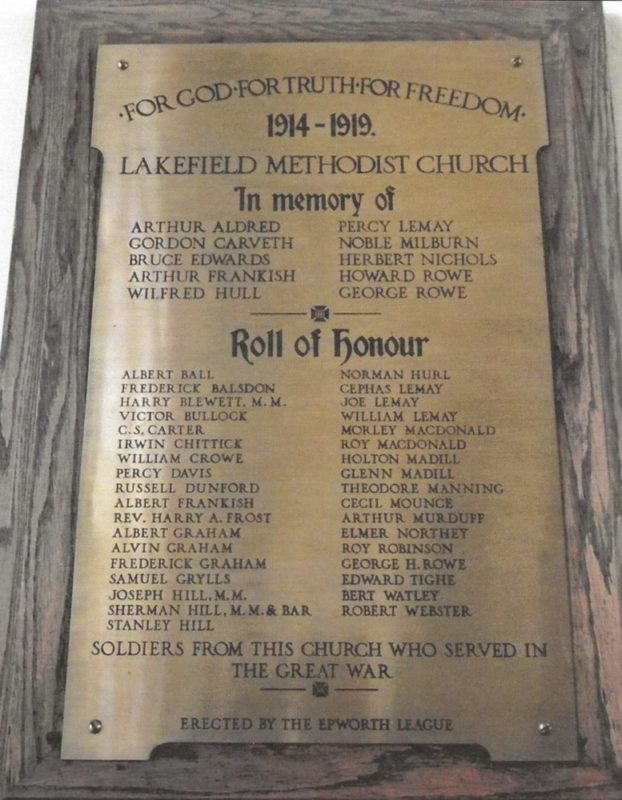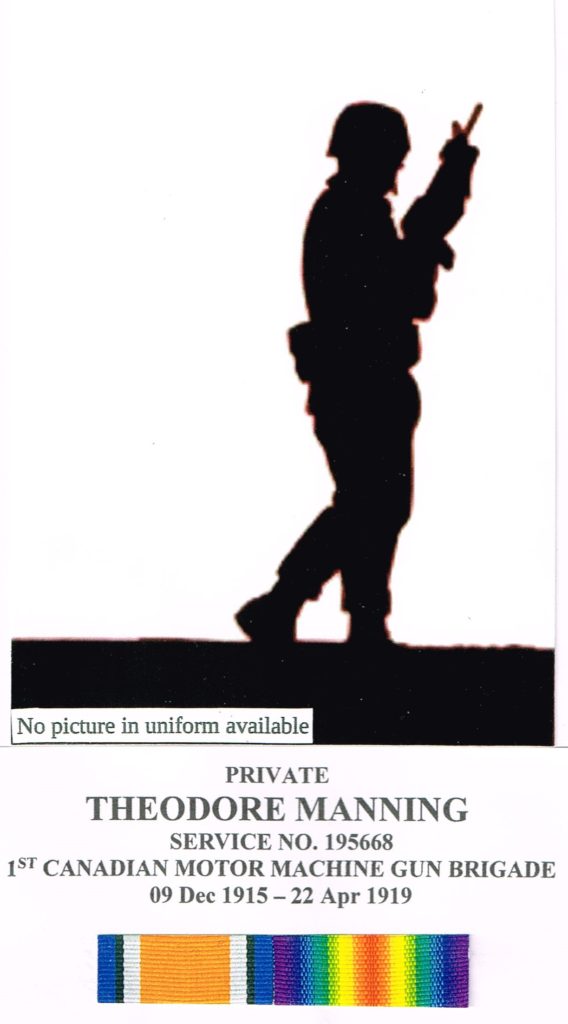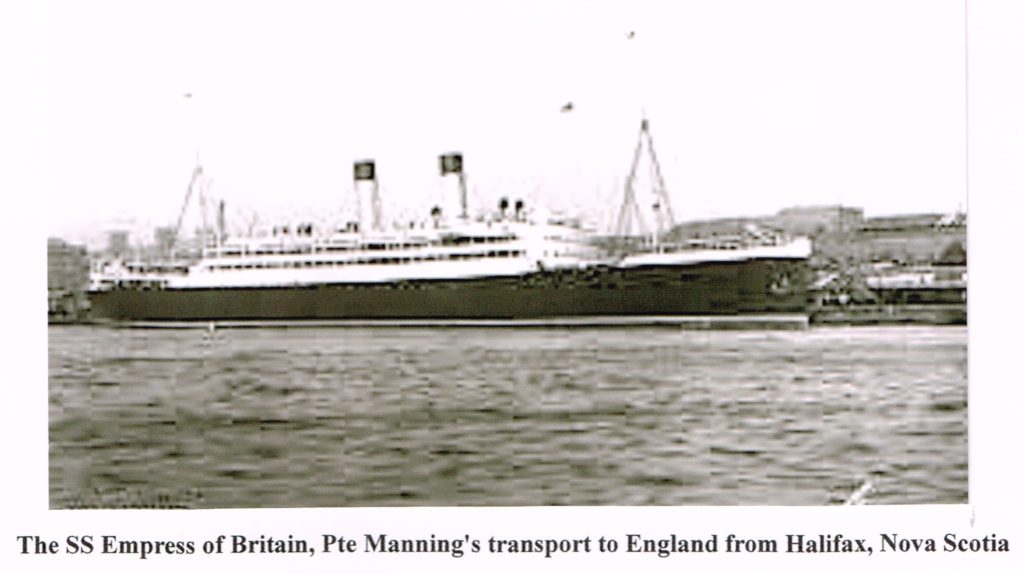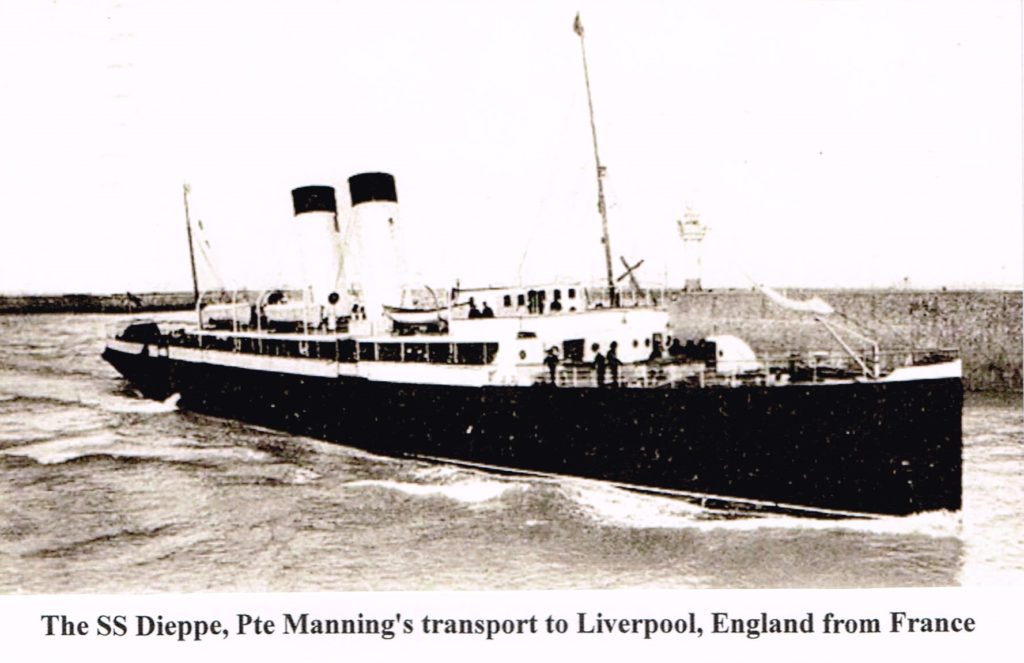MILITARY HISTORY
Private Theodore Manning — 195668 — ACTIVE SERVICE (World War I)
Theodore Manning was 17 years, 4 months and 22 days old when, as a single man, he was Attested in the Canadian Army (CA), Canadian Expeditionary Force (CEF) in Peterborough, Ontario and was enlisted on December 9, 1915 with the 93rd Canadian Overseas Battalion (Cdn O/S Bn), CEF for the duration of the War. Theodore was born in Lakefield, Ontario on July 18, 1898. He was 5′ 6½” tall, dark complexion, hazel eyes, dark brown hair, had a 37″ chest (expanded) and weighed 126 pounds. Theodore gave his occupation as a Canoe Builder and his next-of-kin was his father, Sidney Manning, living in Lakefield. He indicated that he had no experience with the Militia Force nor the Military Force. Theodore’s Medical Examination was done at the 57th Regiment in Peterborough on December 9, 1915; he was found fit for duty. Then, the same day, he was assigned the Rank of Private (Pte); given Regimental Number 195668 and taken-on-strength to the 93rd Cdn O/S Bn CEF. There was a gap of about 7 months from December 9, 1915 to July 15, 1916 due to no data in Pte Manning’s Military File, he would have been training with the 93rd Cdn O/S Bn in Canada. July 1, 1916 Pte Manning made a Pay Assignment of $15.00 monthly to his mother Mrs. Minnie Manning of Lakefield. On July 15, 1916 Pte Manning embarked the SS Empress of Britain at Halifax, Nova Scotia for England. He disembarked at Liverpool, England on July 25, 1916 with the 93rd Cdn O/S Bn CEF.
Pte Manning was in England training with the 93rd Cdn O/S Bn for about 6 weeks when, on September 15, 1916 he was struck-off-strength from the 93rd Cdn O/S Bn on transfer to the 18th Canadian Infantry Battalion (Cdn Inf Bn) at Otterpool, England. September 16, 1916 he arrived at the Canadian Base Depot from the 93rd Cdn O/S Bn and was taken-on-strength of the 18th Cdn Inf Bn in the Field (France) on October 10, 1916. At this point there was a 7-month gap in data due to no data in Pte Manning’s Military File. He would have been training and assigned duties with the 18th Cdn Inf Bn.
On May 25, 1917 Pte Manning was admitted to the 5th Canadian Field Ambulance (CFA) with Pyrexia (PUO), an unknown origin fever of an undetermined cause. The same day he was transferred and admitted to the 1st CFA. Then, on June 26, 1917 Pte Manning rejoined the 18th Cdn Inf Bn in the Field. August 13, 1917 he was admitted to the 4th CFA with Synovitis in the right knee (injured accidentally); two days later on August 15, 1917 he was transferred to the 10th CFA. The next day, August 16, 1917 Pte Manning was admitted to the No 11 General Hospital at Camiers, France with Synovitis in the right knee (severe). August 20, 1917 he was admitted to the No 6 Convalescent Depot at Étaples, France. Then on August 21, 1917 Pte Manning was transferred to the No 5 Convalescent Depot at Cayeux, France. On September 1, 1917 Pte Manning is discharged to Base Details with the Western Ontario Regiment (WOR) in France. September 2, 1917 Pte Manning, under authority of the 2nd Canadian Infantry Battalion Depot (Can Inf Bn Depot) is classified as “Class A” and sent to the 2nd Can Inf Bn Depot. September 18, 1917 Pte Manning arrives at the 2nd Can Inf Bn in the Field. October 29, 1917 while under authority of the Canadian Corps Reinforcement Camp, he is transferred to a Field Ambulance. November 1, 1917 Pte Manning, now with the No 58 Casualty Clearing Station* (CCS) is transferred to the No 2 Ambulance Train with Synovitis in the right knee (slight). *The CCS is the first medical unit (after the Aid Post) for wounded soldiers evacuated from the Front-Lines. Also on November 1, 1917 Pte Manning was admitted to the No 18 General Hospital at Camiers with Synovitis in the right knee. November 29, 1917, with the 18th Can Inf Bn, Pte Manning is discharged to Base Details at the No 2 CIBD. November 30, 1917, again with the 2nd Can Inf Bn Depot, Pte Manning is classified as “Class T B” and went to the 2nd Can Inf Bn Depot. December 12, 1917 due to Synovitis in the right knee still being a problem he is admitted to the No 7 Canadian General Hospital (CGH), at Étaples. December 13, 1917 Pte Manning, with the 2nd Can Inf Bn Depot has been transferred to the No 7 CGH.
January 23, 1918, with the No 7 CGH, Pte Manning will be detained in the Hospital. February 5, 1918 Pte Manning is admitted to the No 6 Convalescent Depot at Étaples from the No 7 CGH. March 15, 1918 he was discharged to Base Details at the Motorboat (MB) Depot at Étaples. March 16, 1918 Pet Manning, at the No 2 Canadian Infantry Brigade Depot (CIB Depot) is classified “Class T B” and admitted to the No 2 CIB Depot. March 26, 1918 he is classified Class “B 1” by a Medical Board (Synovitis right knee). April 2, 1918 Pte Manning is classified “Class A” by a Medical Board (Synovitis right knee). April 6, 1918 he arrived at the Canadian Corps Reinforcement Camp (CCRC). A CCRC is a Centre in France where troops were held before being sent to reinforce existing units. April 15, 1918 Pte Manning is struck-off-strength from the 18th Cdn Inf Bn to the Canadian Machine Gun Reinforcement Pool (CMGRP) in the Field. April 16, 1918 he is taken-on-strength to the CMGRP on transfer from the 18th Cdn Inf Bn. September 17, 1918 Pte Manning is admitted to the No 7 Canadian General Hospital (CGH) at Étaples with Synovitis to the left knee (right knee?). October 19, 1918 he is discharged to the No 3 Entrenching Brigade Depot (Entg Bde Depot) for Base Details from the No 7 CGH and joined them in the Field. October 29, 1918 Pte Manning, with the Canadian General Base Depot (CGBD), left for the Canadian Corps Reinforcement Camp in the Field. November 7, 1918 Pte Manning is struck-off-strength from the Canadian Machine Gun Reinforcement Pool (CMGRP) on transfer to the 1st Canadian Motor Machine Gun Corps (CMMG Corps) in the Field. November 8, 1918, with the CCRC, he is taken-on-strength to the to the 1st Canadian Motor Machine Gun Brigade (CMMGBde) Pool.
January 12, 1919 Pte Manning, with the 1st CMMGBde is struck-off-strength to the Overseas Military Forces of Canada (OMFC) at Seaford. OMFC is a Canadian cabinet ministry that conducted Canadian military affairs in London, England. March 7, 1919 Pte Manning is struck-off-strength from the 1st CMMBde to the
1st Canadian Machine Gun Reinforcement Pool (CMGRP) in the Field. This last movement was cancelled and he proceeded to Seaford England by the SS Dieppe. April 12, 1919 Pte Manning is struck-off-strength from the 1st CMMGB and taken-on-strength to District Depot (DD) No 4 at Montréal Québec, Canada. He was on Draft #46 and embarked at England for Montréal, Québec; he arrived at Montréal about April 20, 1919. April 22, 1919 Private Theodore Manning was struck-off-strength from DD No 4 and the Canadian Army on demobilization at Montréal, Québec.
Private Theodore Manning’s File indicates that he was eligible to receive the following medals which were shipped to him after he was discharged, the:
British War Medal; and
Victory Medal.
He would have also received the CEF Class “A” War Service Badge.
Private Theodore Manning served for about 7 months and 18 days in Canada; 2 months and 27 days in the United Kingdom; 2 years, 5 months and 22 days in France and 20 days Travel Time for a total time of about 3 years, 4 months and 12 days.
Theodore Manning would have received a War Service Gratuity but it wasn’t found in his File, a Clothing Allowance of $100.00 and a Rehabilitation Grant would have been provided.
An excerpt from an article in McLean’s magazine by Barbara Amiel, September 1996:
The military is the single calling in the world with job specifications that include a commitment to die for your nation. What could be more honorable?
Theodore Manning was a member of the Lakefield Methodist Church and is included on a Memorial Plaque which remembers with honour their members who served in the Armed Forces during World War I. This plaque hangs in the Sanctuary of the Lakefield United Church on Regent Street.
PERSONAL HISTORY
THEODORE MANNING
Theodore Manning was born in Lakefield, Ontario on July 19, 1898, the son of William Sidney Manning and Mary “Minnie” Ann Carveth. The family lived on Regent Street in Lakefield and Theodore got his education in the local schools. On December 9, 1915 he enlisted in Lakefield to serve his King and Country
After the war Theodore returned home to Lakefield and found work as a boat builder. On October 25, 1923, Theodore Manning married Gertrude Margaret Behan in St. Michael’s Catholic Church Rectory in Cobourg, Ontario. She was the daughter of Michael Behan and Annie McGuire.
THE THEODORE MANNING FAMILY OF LAKEFIELD
Theodore Manning’s parents were William Sidney Manning born on September 18, 1868 and Mary Ann “Minnie” Carveth born on December 16, 1868. They married in Peterborough in 1897. Mary Ann was previously married to William Henry Mounce and they had three children: Clarence Mounce, born on July 8, 1891; Cecil Henry Mounce, born on July 13, 1892 and Vida Mounce, born on May 27, 1895. William Manning worked as a livery stable keeper and the family lived on Regent Street in Lakefield. Their son Theodore was born on July 18, 1898 and daughter Gladys Irene was born on January 9, 1901 but died two months later, George Gilbert was born August 2, 1904 and Gladys Irene was born on October 22, 1908.
Mary Ann “Minnie” Manning passed away on March 4, 1937 and William Sidney Manning died on July 27, 1952; both are buried in Little Lake Cemetery, Peterborough, Ontario.
Theodore Manning was a member of the Lakefield Methodist church and is included on the Memorial Plaque which honours their members who served in the Armed forced during World War 1. The plaque currently hangs in the sanctuary of the Lakefield United Church 47 Regent Street, Lakefield Ontario.



